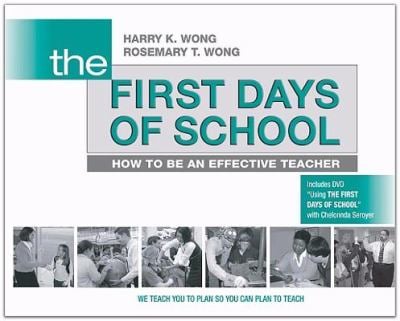 Like many teachers, I praise the book The First Days of School by Wong and Wong. If it's not the Bible of classroom management, then it's at least the Talmud of it. The authors neatly explain tried and true methods of organizing a classroom for student success. And as a convincing kick in the bum, they back it all up with loads of scientific research.
Like many teachers, I praise the book The First Days of School by Wong and Wong. If it's not the Bible of classroom management, then it's at least the Talmud of it. The authors neatly explain tried and true methods of organizing a classroom for student success. And as a convincing kick in the bum, they back it all up with loads of scientific research.But to drive a method home, there's only one thing better than research – hands on experience.
Part 1: Classroom Organization
Thursday's classroom was a living and breathing example of concepts in The First Days of School. This teacher had the room organized to a T. Here are just some of the things I noticed:
- Everyday, students go to the same place to pick up the day's agenda. Its a print out, including the day's plan, the assignments/directions, and rubrics for every assignment.
- The agenda, assignments, papers, etc., are all hole punched so students can (and are required to) easily organize them.
- All desks are numbered. Seats are assigned, but desks are arraigned in a way that facilitate collaborative learning while still keeping attention focused forward to the front of the class.
- A template was created on the front whiteboard for the week's schedule. It never changes or moves, so students always know where to look for deadlines.
- All written papers follow a strict guideline (name in a certain place, double spaced, written neatly in blue/black ink, etc) and is posted throughout the classroom as reminders.
- Work is turned in by students at the same inbox everyday. Work is picked up by students at the same outbox every day.
But what's more impressive: it is only the second week of school and student's know exactly what to do. I attribute this to two things:
- the teacher must have explained it very well to students - but more importantly:
- it was implemented from day one
The result: there is less stress for everybody. Students don't have to worry about asking a multitide of questions just to complete an assignment correctly - they already know what is expected. The teacher doesn't have to make new guidelines for each assignment - they are already in place. Simply collecing a paper goes from a 3-5 minute production to a painless, ritualistic task of students setting them in to a box.
Genius - or common sense? You decide. The fact is it works!
Part 2: Classroom Management
 It is my solid belief that organization and management are completey interrelated. The ying and the yang, the push and the pull, the the demand and the supply. Have one and implement it properly, and the second will follow.
It is my solid belief that organization and management are completey interrelated. The ying and the yang, the push and the pull, the the demand and the supply. Have one and implement it properly, and the second will follow.Again, the experience is the proof. Across all class periods on Thursday, the progression of events at the beginning of class was amazingly similar:
- students walked in before the bell rang
- before sitting down, they went to the side table and picked up the day's agenda
- they went to their assigned desk
- before the bell rang, all students were in the class, seated, and working on their assignments
Compared to my first day subbing on the first day of school (read more about that debacle), this experience proves that organizing a classroom successfully on the first day of school, and implementing it thoroughly, works.
Q. Have you had a similar experience subbing? How did it compare?
Q. What do you intend to do to organize your future (or current) classroom?
I invite you to contribute by sending in questions, personal stories, thoughts, and articles about substitute teaching. Thanks for stopping by.
No comments:
Post a Comment